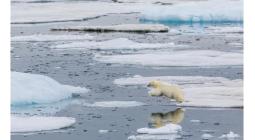Quiet flows the Po: the life and slow death of Italy’s longest river
Italy’s longest river, the Po, was once called the “king of rivers” by Virgil (“fluviorum rex”). It was considered mighty less for its length – it’s only about 400 miles (652 kilometres) long – than for its expanding girth: the countryside next to the river, the Padanian plain, was so flat that the Po was often less of a river than a slow-moving marsh, always flooding land dozens of miles either side of its porous banks.
Since it flows entirely in Italian territory – rising a few hundred metres inside the French-Italian border in the Cottian Alps and heading east until it reaches the Adriatic Sea just south of Venice – the Po is part of the national psyche. The poet Guido Ceronetti once wrote: “You need to understand the Po to understand Italy,” but now – as northern Italy faces its worst drought in 70 years – the river is also a prism through which to glimpse the country’s ecological emergency.
It has, in some places, completely disappeared this summer. Next to Saluzzo, upstream of Turin, I walked from one bank to the other without wetting my feet. There was only white gravel with buddleia where the “great river” was supposed to be. The Po has 141 tributaries, so further downstream the river does return. But two weeks ago, in late June, the flow measured at Pontelagoscuro, near Ferrara, fell below an average of 145 cubic metres per second (the historic average flow for June is 1,805 cubic metres per second). At Cremona – roughly halfway along the Po – the water is currently more than 8 metres (26ft) below “hydrographic zero”.
On Monday, the Italian government declared a state of emergency in five northern regions – Emilia-Romagna, Lombardy, Piedmont, Veneto and Friuli Venezia Giulia. Power stations and spas have been closed, ornamental fountains in Milan have been shut and daytime hosepipe bans are in place because water is simply evaporating faster than it falls.
The Adriatic Sea has come about 12 miles inland from the Po estuary, burning crops and salinating drinking water. The vast maize plantations used for cattle forage are yellowing. Hundreds of thousands of hectares along the Po basin are fallow this summer because of doubts about the reliability of irrigation for the “second planting”.
The river is normally fairly full in June because of snow-melt, but the Italian Society of Environmental Geology recorded only a third of the average snowfall last winter (2.5 metres instead of 7.5 metres). The Gran Paradiso peak (in Piedmont/Aosta) had a snowfall of only 127cm (50in) this winter, compared with this century’s average of 331cm. Even the glaciers are going: last Sunday seven people were killed when a part of the Marmolada glacier broke free, causing a hailstorm of rocks and debris. Another 13, at time of writing, are missing. Last week I went to Trentino, 2,200 metres above sea level, and the peaks around Folgarida and Madonna di Campiglio were stone grey rather than white. It was so warm at altitude that most people were walking only in vests.
The Po tells many other stories about the consequences of human inventiveness and cunning. The river was, for millennia, a vital transport hub, part of the trade route for Baltic amber in the bronze age. Romans navigated the Po from Adria (the town that gave the sea its name) to their fortress in Turin. In the middle ages, dozens of rival signorie (baron states) fought for access to its banks to impose passage taxes and reinforce strategic defences: the Po was always a vast, soggy moat that invaders from the north, such as Hannibal, Attila or Barbarossa, had to cross. So the river became built up with brick castles, watchtowers, chains perpendicular to the flow and pump houses. At the end of the 19th century, there were, it’s thought, 300 flour mills on the river and dozens of bridges made up of strapped-up barges.
But when you paddle and pedal the Po now, its banks are desolate. I travelled from the delta to the source over nine months by canoe, bike, foot and car and it was an industrial rust belt. The discoloured hoppers of gravel-extraction operations and the chimneys of early 20th-century brick furnaces are now cracking and giving in to gravity. Because of the 1951 floods, 80,000 people from Polesine – just inland from the delta – emigrated elsewhere in the 1950s and there are grand houses all over the region overcome with ivy and figs. The castle at Stellata was fissured by the 2012 earthquake. Since you barely see anyone all day, it feels as if you’re visiting Earth after the humans have gone.
The promise of silence and solitude was partly what drew me to the river in the first place. But I also wanted to understand the land where I live. My friends from la Bassa, the lowlands just north of Parma, go almost pagan in describing the sacredness of the river: to them, it is a hallowed container of folklore, legend and memory. They told me about mythological animals such as the Fojonco or villages where socialist violinists had squatted and bought out the local noble’s farm. I followed the stories and slowly came to appreciate my friends’ sense of loss.
The ruin of the river was almost total: paddling against the current, I saw hay-baling plastic, a tennis ball, a Nerf gun bullet
The river was always both a donor and a thief, gifting land but also robbing it. It’s commonly called a “traitor” or “promiscuous” because it had a habit of leaving its established bed and changing course. Settlements that were once on the left bank are now on the right, and vice versa. Near Valenza, there’s a village called Alluvioni Cambiò (“flood-changed”). The river’s deliverance of silt even became an instrument of expansionism: almost as soon as the house of Este at Ferrara died out in 1597, the Venetian republic radically altered the direction of the Po (1600-04), forcing it south with a four-mile cut so that Ferrara’s harbours became silted up and the Venetians could reclaim the land where the river had once run.
The word for land reclamation, the draining of the swamps and floodplains, is bonifiche, which implies a “making good”. Industrialisation meant that coal pump houses were capable of moving millions of gallons in a day: through the 20th century, the number of valli – lagoons – were reduced from 50 to just 24; between 1957 and 1975, 18,000 hectares (44,000 acres) of the Mezzano lagoon disappeared.
Water removal meant that the new lands were often below the level of the river. The discovery of methane in the 1920s and its extraction through following decades meant that land levels slipped another vital metre or two. The natural obedience of water to gravity was being challenged by human hubris. Mechanised banking of the river was now needed to protect the hard-won land because the Po became “perched”, meaning above the level of the surrounding countryside. In Polesine you go up to, not down to, the river.
The shrewd fishermen of Comacchio had once trapped and smoked eels (it was the subject of one of Sophia Loren’s earliest films, The River Girl), but the eels were becoming rarer because of the lack of habitat so the fishermen started farming clams, creating an industry in the postwar years worth an estimated €100m (£86m) annually. Refrigerated white vans now speed along the narrow roads on the delta, starting their journeys to the restaurants and markets of Europe.
Human intervention upended ecosystems: the coypu was introduced from South America for its fur, but when that industry ended, the nutrie had no predators and merrily multiplied. They now gnaw on the banks for roots, graze among the pumpkins and melons, and then plop into water, gliding with their nostrils poking above the algal blooms.
Every industry along the Po seemed to stain or change it. Its waters were used to cool power stations, so red-and-white chimneys are often, along with pylons, the most prominent sights from the canoe. Star cucumber (known as zucca pazza or “mad pumpkin”) was introduced from the Americas to give shade to Italian orchards, but the plant went rogue and now covers the floodplains like a lumpy silk carpet. The ugly wels catfish has almost entirely eradicated the native sturgeon, source of the once-prized Po caviar. Canadian poplars were introduced and now stand like regimented troops, all parallel and perpendicular.
The ruin of the river was almost total: as I paddled against the current, I would memorise the objects I saw: hay-baling plastic, tennis ball, Nerf gun bullet. What I didn’t see was even more alarming: pollution has improved from the high point in the mid-1990s (when the Po was estimated to disburse into the Adriatic every year 2,642kg of zinc, 1,154kg of copper, 1,312kg of lead, 944kg of chrome and 243kg of arsenic), but analysts still frequently see peaks in benzoylecgonine, a chemical excreted by cocaine users in urine, in the aftermath of high weekends.
During my journey the air quality was, if anything, even worse than that of the water. The polythene sky of the Padanian plain through winter is partly the result of thick fogs, but those fogs also occur because of the habit of drenching farmland in nitrogen fertilisers that then volatilise to form ammonium salts. Fertiliser run-offs also cause those algal blooms because of eutrophication – which occurs when waters become overenriched with nutrients and minerals, typically from agriculture – in our ever-slower rivers. Most irrigation channels look like bowling creases.
But just as I began to despair about the ecological disaster of the river, something uplifting and intriguing emerged. Because land adjacent to the river frequently flooded, it was precarious and therefore affordable. It was somewhere the impoverished and dispossessed found shelter. The floodplains attracted outlaws because the Po always marked the border between rival jurisdictions and it was easy to slip across the river to avoid arrest. In the 19th century, live music was forbidden without a permit so various musical ensembles held concerts on bridges so that they could shuffle to one end or the other according to the police presence. One village next to the Po, Rea, possibly gets its name from a twist on “guilty” and another – Bergantino – probably comes from “brigand”.
The riverbanks were often the sites of socialist or surrealist communes and of lazarets (quarantine quarters)
“It’s as if there’s an anarchic and libertarian spirit that attracts particular individuals to the Po,” the documentary-maker and musician Alessandro Scillitani wrote recently. “People who have decided to live in their own way and thus have a vision of the world different to ours.” It’s something that has been noted for centuries, with all sorts of explanations: the Po just draws “personalities who are a bit strange”, says the photographer Riccardo Varini. “It’s a land of contraband …”
As I tramped from one village to the next, I came across a subculture of puppeteers, musicians, fairground-ride inventors and naive artists. I noticed how many of Italy’s 20th-century film directors were either born along the banks of the Po or else kept coming back to the river for its simplicity and discernible lunacy. Films such as Michelangelo Antonioni’s Il Grido (The Cry) or Luchino Visconti’s Ossessione (Obsession) reinforced my sense that the river, passing through the most industrialised regions of Italy, was once a free enclave of vagabonds and itinerants. Both films were about loners living rough along its muddy banks. Ossessione was a liberal adaptation of James M Cain’s The Postman Always Rings Twice.
Because the river made land and possessions impermanent, over the centuries, many villagers decided to offer each other an effective insurance policy by holding land in common. At Coltaro, near Parma, the floodplains have been held communally by the villagers since 1588. Privatisations have eaten into the commonhold, but even today 1.3m sq metres (14m sq ft) are shared by the villagers, meaning that each has about a hectare of land. At Trino, towards Turin, there’s an extraordinary communal woodland that has been operative since the late 13th century: it’s called “the woodland of fates” because the felling areas are assigned by drawing lots every autumn. The riverbanks were often the sites of socialist or surrealist communes and of lazarets (quarantine quarters), something given added resonance in our era of Covid and contagion.
It wasn’t just cheap or precarious land that nurtured communalism. As Giulio Boccaletti shows in his eloquent 2021 book, Water, notions of citizenship and democracy have often been forged by the need to “develop institutions to manage the consequences of a sedentary life in a world of moving water.” The Lombard League (an alliance of the usually fractious city states of northern Italy) was created in 1167 in part to reject the water-grab by Holy Roman emperor Frederick Barbarossa, who at the Diet of Roncaglia (1154-58) had claimed ownership of the Po, its precious waters and its fish.
After the construction of the Cavour canal, north of the Po, in the 1860s, the Italian rice industry became hydrologically viable, and sophisticated irrigation agreements were drawn up between the great monasteries and tenant farmers to flood the fields of Lomellina. Here, too, the water forced social mobilisation: the exploitation of female manual labourers – the mondine, or weeders – gave rise to unionism and successful campaigns for an eight-hour day. The arduous 40-day weeding had a Lenten feel and the mondine had a playbook of bagpipey “Lombardy-blues” songs taken from the socialist, military, partisan and feminist repertoire: “Shut up, shut up, husband of mine” is my current favourite. Now, though, there are no manual labourers left in these fields, only 20-metre boons, triangled like a crane arm, that spray weedkillers into the water.
I was often drawn to the traces of the cottage industries that relied on the Po’s waters. Carmagnola was the capital of international hemp trading from the 16th to 18th centuries. Its covered market was where hemp uniforms and ropes were sold to emissaries of the maritime republics of Genoa and Venice. Hemp production was basic: the long stalks of cannabis sativa were rotted in the ditches so they could be stripped down, beaten, combed and spun. You can still see one or two long arcades where women and children twisted, soaked and scrubbed the rope. A few farmhouses have holes where poles were inserted like rigid clothes lines on which to dry fibres.
Just occasionally there were botanical connections between the Po and England. Pancalieri, south-west of Turin, is a tiny town. Even here, from where you can see the equilateral peak of Monviso at almost 4,000 metres, you’re only 243 metres above sea level. Pancalieri’s low-lying marshes (the name means “waning plain”) made it ideal for a cottage industry that had thrived in the 1800s in the then Surrey village of Mitcham: the cultivation and distillation of lavender and mint and the transformation of their essences into cosmetics and tinctures (the crest of the south-west London football team Tooting & Mitcham still boasts lavender flowers curving around a tower).
Turin was the centre of Italian chemistry and various investors and farmers decided to imitate Mitcham’s know-how and farm peppermint in the rich soils adjacent to the Pancaliera stream. Pancalieri, the town, now grows half of all Italian mint, the main client being the nearby confectionery giant Ferrero, producer of, among much else, Tic Tacs.
But the horror of writing a book about the natural world in 2022 is that everything has turned inside out. Almost all the images of the river through history are of a male thug (“a drunken father”, according to Gianni Brera, the great sportswriter, who was born in San Zenone al Po). The fears of Po-side humans were always focused on floods, but suddenly centuries of architecture and literature seem redundant because we now we have exactly the opposite fear: not an excess, but a lack, of water. Even the mountain where the Po rises, Monviso, is crumbling as the glacial glues give way. My hike to the source was interrupted every hour by the roar of a small rockslide and the puff of smaragdite dust. Despite the damp mosses of the Alpine tundra, the Po is slimmer every year, less a drunken father now than an absent one.
-
The Po: An Elegy for Italy’s Longest River is published by Head of Zeus (£25). To support the Guardian and Observer order your copy at guardianbookshop.com. Delivery charges may apply





